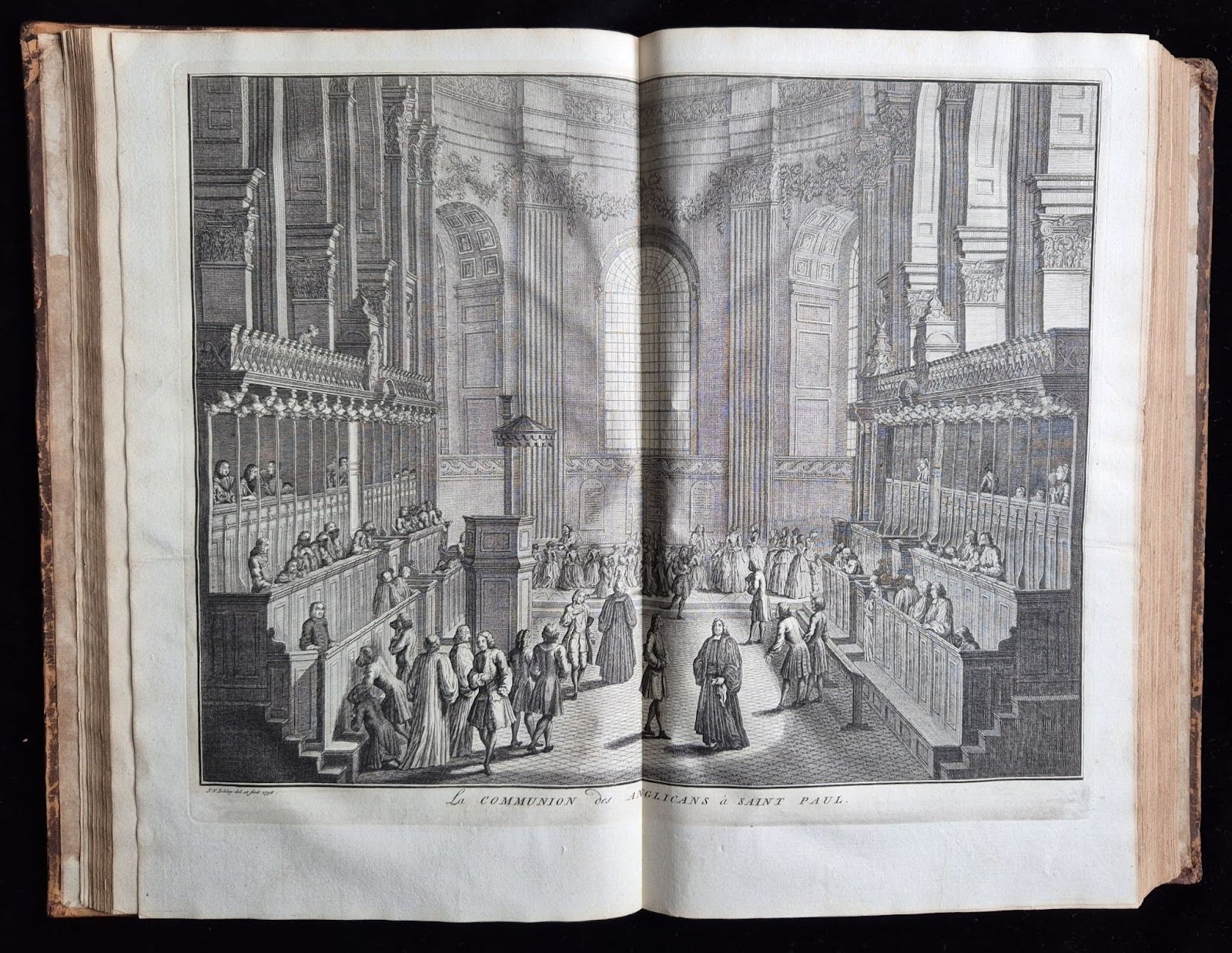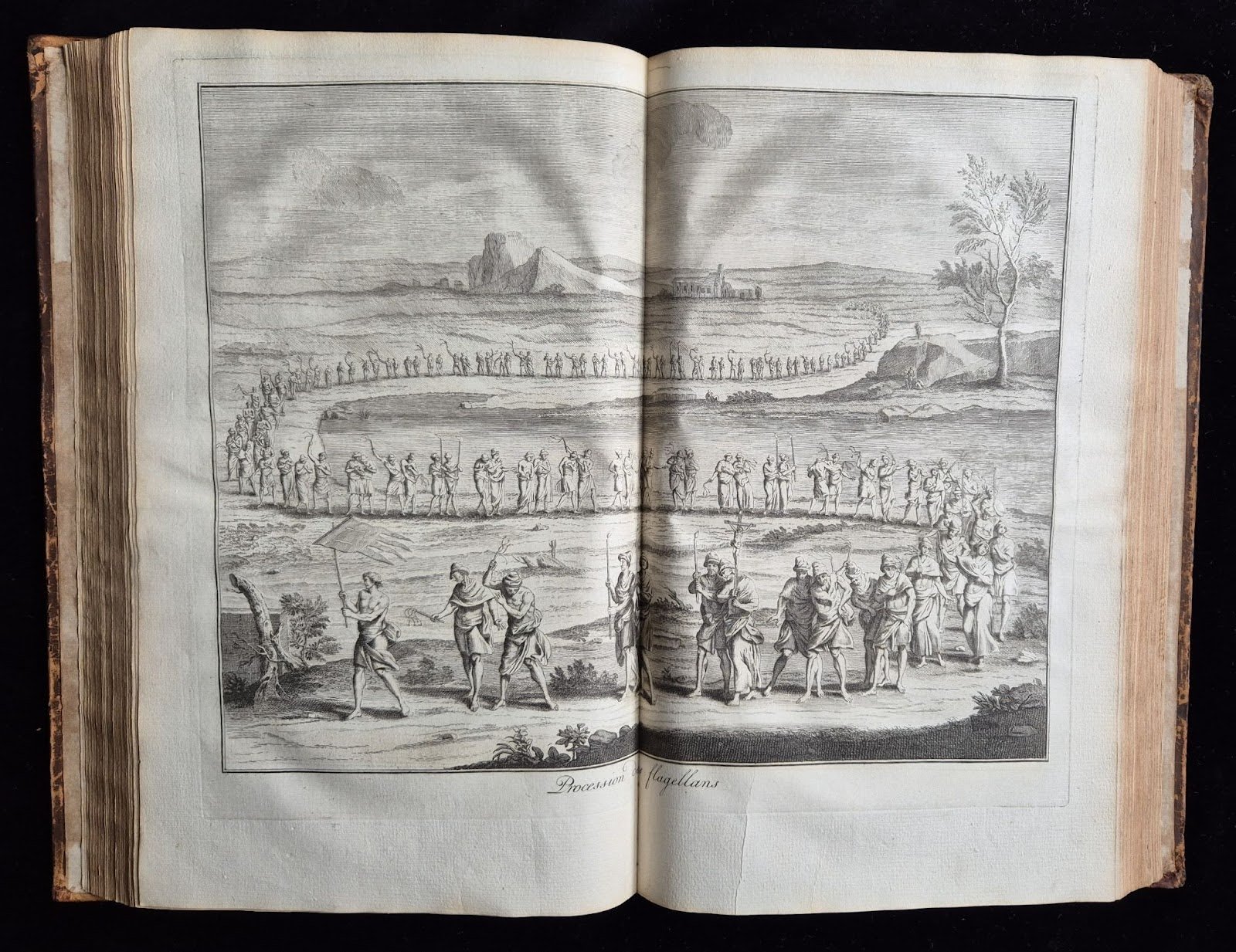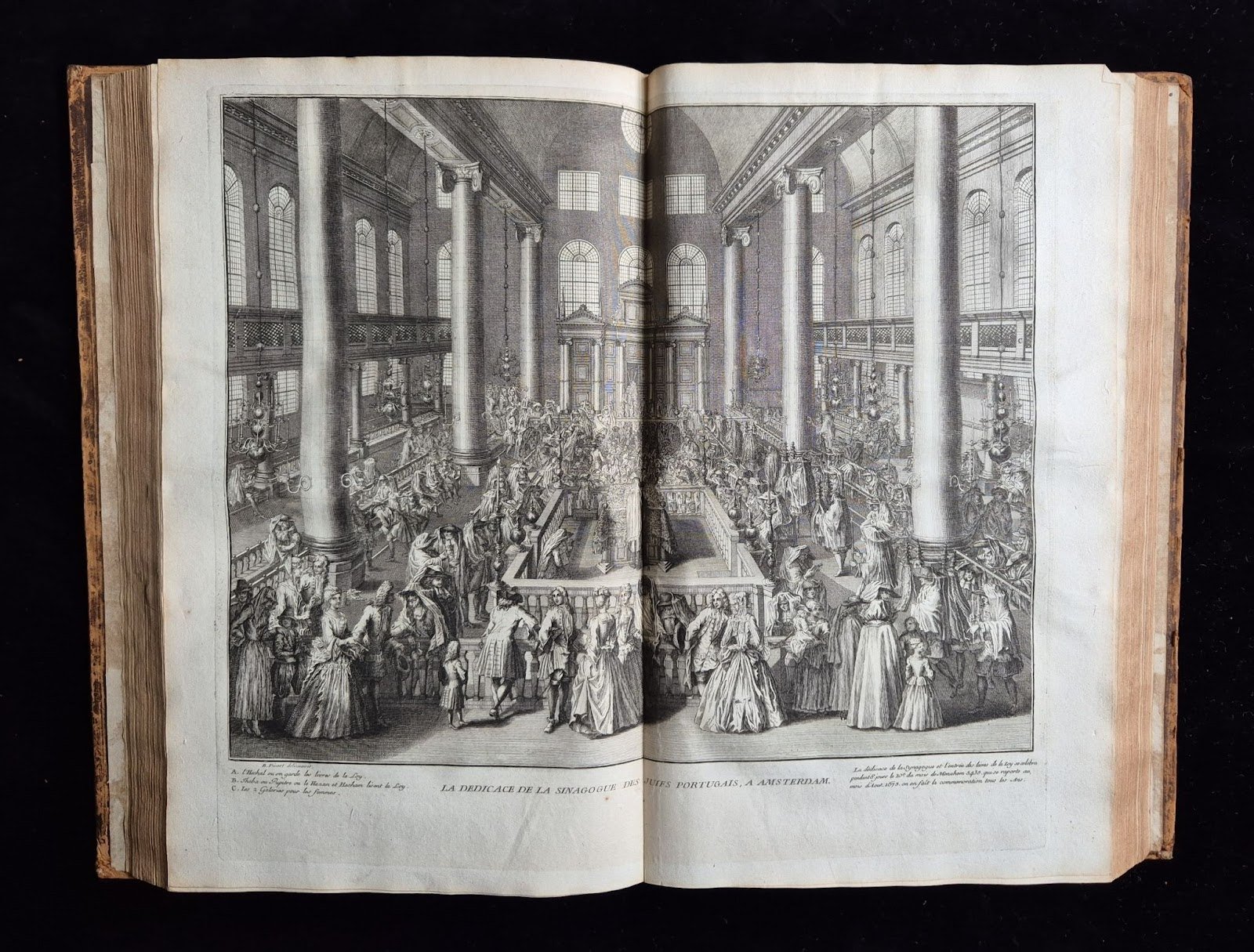 Image 1 of 6
Image 1 of 6

 Image 2 of 6
Image 2 of 6

 Image 3 of 6
Image 3 of 6

 Image 4 of 6
Image 4 of 6

 Image 5 of 6
Image 5 of 6

 Image 6 of 6
Image 6 of 6







The Religious Ceremonies and Customs of the Several Nations of the Known World...
PICART, Bernard [illustrator], BERNARD, Jean-Frédéric [editor]. The Religious Ceremonies and Customs of the Several Nations of the Known World...[vols I - III] | The Ceremonies and Religious Customs of the Idolatrous Nations...[vols. IV - VII].
London: Nicholas Prevost, and Comp., 1731 [vols I - III] | James Bettenham, for Claude du Bosc, 1735/1736/1737/1739.
7 volumes in 6. Folio (395 x 250 mm.). With 221 magnificent engraved plates, many double-page, some folding. Title with engraved vignette after J. Vander Gucht, and engraved headpieces etc. by F. Morelon la Cave. Title of Vol IV mis-named 'Vol IV Part II’; small circular stain to lower portion of half-title of volume I. Occasional light spotting or browning to text, including volume V, and one plate in volume III, lacking some final blanks, first double plate in volume I coming away from guards in lower gutter, but holding fast, short tear to lower portion of Zzzz2 in volume IV affecting a few words of text but with no lack, and another to 5C, tp of volume VI a little lightly browned; overall very good and clean internally, especially the plates, which are crisp and fresh. In contemporary speckled calf, neatly rebacked, boards a little scuffed and rubbed, corners bumped but attractive nonetheless. 19th century engraved armorial ex libris 'Alington', presumably of Henry Gerard Sturt, first Baron Alington (1825-1904).
"THE BOOK THAT CHANGED EUROPE". A milestone work, it "sowed the idea that religions could be compared on equal terms." Picart and Bernard were Huguenot refugees in Amsterdam. Picart was the most famous engraver of the 18th century after Hogarth; his father, Etienne Picart, had been an engraver before him.
This monumental work, a most broad-ranging survey of both European and non-European religions, in fact covering all the religions known to Europeans in the early 18th century, including Judaism, Catholicism, Protestantism, and Islam (among others), was first published in Amsterdam in eleven volumes, from 1723-37 and had more than 3,000 pages and 250 plates.
Amsterdam at the time was an excellent place to observe Jewish life, it being home to the Sephardi community's Great Synagogue, the model for London's Bevis Marks (the oldest continually functioning Synagogue in Europe), and indeed the Synagogue is here represented in a splendid double-page plate. It is, however, more wide-ranging than that, and as well as discussing both "Spanish" (Sephardi) and "German" (Ashkenazi) communities, it even mentions Chinese Jews!
The book includes sections on all sorts of aspects of Jewish life, from the washing of hands to relations with women, witchcraft, and 'easing oneself'. There is a valuable commentary on "The punishments inflicted on the Jews; and the Badges they have been obliged to wear, as a Distinction from Christians..."
The section on Catholicism was the longest in the original work, taking up one-sixth; and while both men were Protestant, they did not want to antagonize their potentially large Catholic Francophone readership - this section also includes the most illustrations, among them of the election of a Pope, of the performance of the Mass, the blessing of bells, the translation of relics, and so on. There is also discussion of the Congregatio de Propaganda Fide, the Papal Court, and the History of the Inquisition (with a plate showing methods of torture by Inquisitors).
Volume III looks at religions in the Americas - including various tribes of Native Americans - discussing the ornamentation of the body, their diet, marriage habits, and so on, in a number of states - Florida, Virginia, Mississippi just to name a few. There are illustrations of tomahawks and peace pipes, but also covered are religions in Mexico, Peru, and Canada, including an illustration of the Templo Mayor in the Aztec Capital. The remaining volumes are dedicated to India (Castes, Brahmins, Fakirs, etc.), Japan, Persia, Africa, and finally, the Orthodox Christian Churches (including Russia) and Protestantism.
A massive undertaking, the printing of the first three volumes of this set were published by Nicholas Prevost, while the final three were published in various iterations for or by Claude du Bosc; together they make the complete set found here, obviously bound to match in speckled calf for a contemporary owner at the time.
A handsome set of the FIRST EDITIONS IN ENGLISH of a major milestone in European attitudes to religion by one of the foremost illustrators of the 18th century.
ESTC T137604, Brunet I, 1742, Sabin 4934; cf. Lynn Hunt et al. The Book that Changed Europe: Picart and Bernard's Religious Ceremonies of the World, Harvard UP, 2010.
PICART, Bernard [illustrator], BERNARD, Jean-Frédéric [editor]. The Religious Ceremonies and Customs of the Several Nations of the Known World...[vols I - III] | The Ceremonies and Religious Customs of the Idolatrous Nations...[vols. IV - VII].
London: Nicholas Prevost, and Comp., 1731 [vols I - III] | James Bettenham, for Claude du Bosc, 1735/1736/1737/1739.
7 volumes in 6. Folio (395 x 250 mm.). With 221 magnificent engraved plates, many double-page, some folding. Title with engraved vignette after J. Vander Gucht, and engraved headpieces etc. by F. Morelon la Cave. Title of Vol IV mis-named 'Vol IV Part II’; small circular stain to lower portion of half-title of volume I. Occasional light spotting or browning to text, including volume V, and one plate in volume III, lacking some final blanks, first double plate in volume I coming away from guards in lower gutter, but holding fast, short tear to lower portion of Zzzz2 in volume IV affecting a few words of text but with no lack, and another to 5C, tp of volume VI a little lightly browned; overall very good and clean internally, especially the plates, which are crisp and fresh. In contemporary speckled calf, neatly rebacked, boards a little scuffed and rubbed, corners bumped but attractive nonetheless. 19th century engraved armorial ex libris 'Alington', presumably of Henry Gerard Sturt, first Baron Alington (1825-1904).
"THE BOOK THAT CHANGED EUROPE". A milestone work, it "sowed the idea that religions could be compared on equal terms." Picart and Bernard were Huguenot refugees in Amsterdam. Picart was the most famous engraver of the 18th century after Hogarth; his father, Etienne Picart, had been an engraver before him.
This monumental work, a most broad-ranging survey of both European and non-European religions, in fact covering all the religions known to Europeans in the early 18th century, including Judaism, Catholicism, Protestantism, and Islam (among others), was first published in Amsterdam in eleven volumes, from 1723-37 and had more than 3,000 pages and 250 plates.
Amsterdam at the time was an excellent place to observe Jewish life, it being home to the Sephardi community's Great Synagogue, the model for London's Bevis Marks (the oldest continually functioning Synagogue in Europe), and indeed the Synagogue is here represented in a splendid double-page plate. It is, however, more wide-ranging than that, and as well as discussing both "Spanish" (Sephardi) and "German" (Ashkenazi) communities, it even mentions Chinese Jews!
The book includes sections on all sorts of aspects of Jewish life, from the washing of hands to relations with women, witchcraft, and 'easing oneself'. There is a valuable commentary on "The punishments inflicted on the Jews; and the Badges they have been obliged to wear, as a Distinction from Christians..."
The section on Catholicism was the longest in the original work, taking up one-sixth; and while both men were Protestant, they did not want to antagonize their potentially large Catholic Francophone readership - this section also includes the most illustrations, among them of the election of a Pope, of the performance of the Mass, the blessing of bells, the translation of relics, and so on. There is also discussion of the Congregatio de Propaganda Fide, the Papal Court, and the History of the Inquisition (with a plate showing methods of torture by Inquisitors).
Volume III looks at religions in the Americas - including various tribes of Native Americans - discussing the ornamentation of the body, their diet, marriage habits, and so on, in a number of states - Florida, Virginia, Mississippi just to name a few. There are illustrations of tomahawks and peace pipes, but also covered are religions in Mexico, Peru, and Canada, including an illustration of the Templo Mayor in the Aztec Capital. The remaining volumes are dedicated to India (Castes, Brahmins, Fakirs, etc.), Japan, Persia, Africa, and finally, the Orthodox Christian Churches (including Russia) and Protestantism.
A massive undertaking, the printing of the first three volumes of this set were published by Nicholas Prevost, while the final three were published in various iterations for or by Claude du Bosc; together they make the complete set found here, obviously bound to match in speckled calf for a contemporary owner at the time.
A handsome set of the FIRST EDITIONS IN ENGLISH of a major milestone in European attitudes to religion by one of the foremost illustrators of the 18th century.
ESTC T137604, Brunet I, 1742, Sabin 4934; cf. Lynn Hunt et al. The Book that Changed Europe: Picart and Bernard's Religious Ceremonies of the World, Harvard UP, 2010.
PICART, Bernard [illustrator], BERNARD, Jean-Frédéric [editor]. The Religious Ceremonies and Customs of the Several Nations of the Known World...[vols I - III] | The Ceremonies and Religious Customs of the Idolatrous Nations...[vols. IV - VII].
London: Nicholas Prevost, and Comp., 1731 [vols I - III] | James Bettenham, for Claude du Bosc, 1735/1736/1737/1739.
7 volumes in 6. Folio (395 x 250 mm.). With 221 magnificent engraved plates, many double-page, some folding. Title with engraved vignette after J. Vander Gucht, and engraved headpieces etc. by F. Morelon la Cave. Title of Vol IV mis-named 'Vol IV Part II’; small circular stain to lower portion of half-title of volume I. Occasional light spotting or browning to text, including volume V, and one plate in volume III, lacking some final blanks, first double plate in volume I coming away from guards in lower gutter, but holding fast, short tear to lower portion of Zzzz2 in volume IV affecting a few words of text but with no lack, and another to 5C, tp of volume VI a little lightly browned; overall very good and clean internally, especially the plates, which are crisp and fresh. In contemporary speckled calf, neatly rebacked, boards a little scuffed and rubbed, corners bumped but attractive nonetheless. 19th century engraved armorial ex libris 'Alington', presumably of Henry Gerard Sturt, first Baron Alington (1825-1904).
"THE BOOK THAT CHANGED EUROPE". A milestone work, it "sowed the idea that religions could be compared on equal terms." Picart and Bernard were Huguenot refugees in Amsterdam. Picart was the most famous engraver of the 18th century after Hogarth; his father, Etienne Picart, had been an engraver before him.
This monumental work, a most broad-ranging survey of both European and non-European religions, in fact covering all the religions known to Europeans in the early 18th century, including Judaism, Catholicism, Protestantism, and Islam (among others), was first published in Amsterdam in eleven volumes, from 1723-37 and had more than 3,000 pages and 250 plates.
Amsterdam at the time was an excellent place to observe Jewish life, it being home to the Sephardi community's Great Synagogue, the model for London's Bevis Marks (the oldest continually functioning Synagogue in Europe), and indeed the Synagogue is here represented in a splendid double-page plate. It is, however, more wide-ranging than that, and as well as discussing both "Spanish" (Sephardi) and "German" (Ashkenazi) communities, it even mentions Chinese Jews!
The book includes sections on all sorts of aspects of Jewish life, from the washing of hands to relations with women, witchcraft, and 'easing oneself'. There is a valuable commentary on "The punishments inflicted on the Jews; and the Badges they have been obliged to wear, as a Distinction from Christians..."
The section on Catholicism was the longest in the original work, taking up one-sixth; and while both men were Protestant, they did not want to antagonize their potentially large Catholic Francophone readership - this section also includes the most illustrations, among them of the election of a Pope, of the performance of the Mass, the blessing of bells, the translation of relics, and so on. There is also discussion of the Congregatio de Propaganda Fide, the Papal Court, and the History of the Inquisition (with a plate showing methods of torture by Inquisitors).
Volume III looks at religions in the Americas - including various tribes of Native Americans - discussing the ornamentation of the body, their diet, marriage habits, and so on, in a number of states - Florida, Virginia, Mississippi just to name a few. There are illustrations of tomahawks and peace pipes, but also covered are religions in Mexico, Peru, and Canada, including an illustration of the Templo Mayor in the Aztec Capital. The remaining volumes are dedicated to India (Castes, Brahmins, Fakirs, etc.), Japan, Persia, Africa, and finally, the Orthodox Christian Churches (including Russia) and Protestantism.
A massive undertaking, the printing of the first three volumes of this set were published by Nicholas Prevost, while the final three were published in various iterations for or by Claude du Bosc; together they make the complete set found here, obviously bound to match in speckled calf for a contemporary owner at the time.
A handsome set of the FIRST EDITIONS IN ENGLISH of a major milestone in European attitudes to religion by one of the foremost illustrators of the 18th century.
ESTC T137604, Brunet I, 1742, Sabin 4934; cf. Lynn Hunt et al. The Book that Changed Europe: Picart and Bernard's Religious Ceremonies of the World, Harvard UP, 2010.

